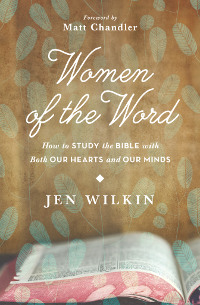Book review: Women of the Word
- Jean Williams •
- 30 October 2015

Jen Wilkins, Women of the Word, Crossway, Wheaton, 2014
We can be a bit lazy when we read the Bible. We open it to random passages. We stick to our favourite books. We stop reading once we’ve found our take-home point for the day. It’s pretty appalling when you stop to think about it: we have God’s very words, yet we sometimes treat them like a collection of inspirational thoughts or a Magic 8 Ball.
Perhaps what we need is practical answers to questions like these: When I open my Bible in the morning, what can I do to better understand God’s Word? As I prepare a Sunday School lesson or Bible study, how do I get to grips with the passage so I can teach it to others? If I’m training someone to read and teach God’s Word, what tools can I put into their hands?
The other day I sat in a plane and pulled Jen Wilkin’s Women of the Word: How to study the Bible with both our hearts and our minds out of my bag. It looked like a short and easy read, and sure enough I’d read the first half by the end of my Melbourne to Sydney flight. I finished the rest the next day, and realized I was holding a gem, and not just for women: this is a brilliant book to help men explore and understand God’s Word too. I highly recommend it, both for personal encouragement and ministry training.
Women of the Word invites us to read the Bible with our minds as well as our hearts. To let it tell us about God rather than just about ourselves. To do the hard work of digging into the text and taking time to understand what we are reading. And if that sounds daunting, Wilkin doesn’t leave it there: she gives us five tools to use as we learn to engage with God’s good words.
Like many teachers and preachers, Wilkin loves alliteration, and for some reason it’s always the Ps that summarize the message. Her five Ps for understanding the Bible receive one chapter each:
- Study with purpose. Wilkin teaches us to put the passage in the context of the ‘metanarrative’ of Scripture, which is a fancy way of saying that she encourages us to discover each passage’s place in the big story of God’s salvation.
- Study with perspective. Here’s where we ask “Who? When? To whom? How? Why?”. It’s great to have a set of simple and useable tools for getting to grips with authorship, cultural context and style, so that we can understand where the passage is coming from, and (just as important!) not misunderstand it as we read it through modern eyes.
- Study with patience. I thought this was the best chapter in the book. Wilkin encourages us to live with dissonance as we study a passage—that feeling of discomfort, like we don’t understand or are uncomfortable with what we read—rather than ignoring bits we don’t like or hurrying to a solution. She encourages us to take the time to understand the passage for ourselves before we reach for a commentary or a sermon. Excellent!
- Study with process. This is a fantastic method to use to come to grips with a passage, either during our personal Bible reading or as we prepare a Bible study: print out the text, read repetitively, annotate and outline, and so on. I already use a similar method myself, but it’s great to have the steps spelled out so clearly. Get out your coloured pens!
- Study with prayer. This goes without saying, yet we often forget it: we need God’s help before, during, and after we seek to understand his Word.
Wilkin concludes with a chapter for female Bible teachers that: explains why we need women teachers (this section is gold); addresses common pitfalls in teaching women, such as feminizing the text; and gives practical advice on writing a curriculum.
I have very few criticisms of this book. The context of the chapter on teaching women may feel a bit foreign to some readers. (How many Australian churches employ a woman to teach the Bible to women for two hours a week? Although perhaps we could learn from this practice.) I would have liked to see the five steps set out in a summarized form at the back of the book for use in Bible reading and training (note to publishers: it would be great to see this in future editions). But that’s about it.
Jen Wilkins calls her book Women of the Word, but, as I’ve said, this book isn’t just for women. Men and pastors, I encourage you to read it too. Whether you’re a Christian who wants to learn how to read the Bible for yourself, a Sunday School teacher or Bible teacher who would like to prepare and teach God’s Word more faithfully, or a ministry trainer who works to equip others to understand and teach God’s Word, this book is for you.





